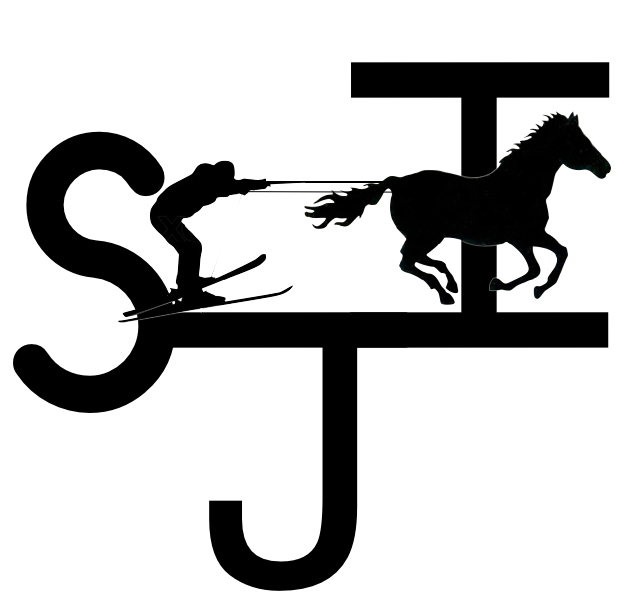A BRIEF HISTORY OF THE SPORT by Loren Zhimanskova
The first report of a person being pulled on skis (or wooden boards) by an animal or animals, dogs in this case, was recorded by a Persian historian thousands of years ago in the Altai Mountains of Central Asia, where Russia, China, Mongolia and Kazakhstan come together.
For hundreds of years, Laplanders have been harnessing reindeer and strapping on Nordic skis as a way to travel across vast snowy expanses, and skijoring (spelled skijøring or skikjoring in Norwegian and meaning "ski driving") is now popular in all Scandinavian countries. By 1912, skijoring behind horses was a popular activity in Switzerland and France. It did not take long for this activity to cross the Atlantic. In the 1950's and 1960's, the Swiss and Austrians took to skijoring behind automobiles and motorcycles.
In the early 1900's, equine skijoring found its way to North America. In 1915, it appeared as a recreational activity in Lake Placid, New York and was a regular pastime at the Dartmouth Winter Carnival in Hanover, New Hampshire. As early as 1930, mountain towns like Jackson Hole, Wyoming and Steamboat Springs, Colorado took up the sport often running in pairs down main streets. When World War II ended, men from the 10th Mountain Division, our "Soldiers on Skis", returned home. There were no ski resorts or lifts back then, so they had their cowboy friends attach a long rope to their saddle horn, and then they held on as the horse was ridden at high speeds down a long straight-away usually an open field of a snow covered roadway. Thus, American races were born.
Today, equine skijoring is a highly specialized competitive sport, where horses accelerate to over 40 mph in just three strides covering a straight track roughly 900' in length. Skiers must navigate a series of jumps and gates and, in some cases, capture rings while being pulled by a 30' rope at speeds up to 60 mph as they accelerate. Curved tracks are also used in northern states such as Montana.
Competitive skijoring races are currently taking place in over 8 states in the USA as well as in St. Moritz, Switzerland and Alberta, Canada, The sport is practiced in various ways and across numerous countries worldwide: France, Poland, Latvia, Norway, Sweden, Finland, Ukraine and Russia. In the United Kingdom, athletes are skijoring on turf or in arenas. In some coastal regions, skijoring occurs on beaches.
Skijoring made its official debut in Stockholm at the Winter Games of 1901, 1906 & 1909. In 1924, equine skijoring made an appearance at the Chamonix International Winter Sports Week Games (later to be called the First Winter Olympic Games) which set the stage for its inclusion as an exhibition sport at the 1928 Winter Olympic Games in St. Moritz, Switzerland. In 1976, Denver, Colorado listed skijoring as an exhibition sport in their bid for the Winter Olympics. Denver won the bid, but ultimately turned it down, and skijoring was destined to remain in the shadows. Skijor International, LLC and Skijor USA, a non-profit organization, are working to bring skijoring back to the 2030 Winter Olympics in Chamonix, France and the 2034 Winter Olympics in Salt Lake City in some capacity.
Today, in Europe, equine skijoring gets the most exposure during White Turf in St. Moritz, Switzerland. White Turf, an event which features horse racing on snow as well as chariot racing and skijoring, began in 1907 and draws over 35,000 spectators a day.
In the United States, Leadville, Colorado has been hosting a competition down its main street since 1949. Other popular venues include Boulder, Sheridan, Wisdom, Bozeman, Red Lodge, Whitefish, Big Sky and West Yellowstone, Montana; Hailey, Marsh Valley and Driggs, Idaho; Bondurant, Saratoga, Sundance, Pinedale and Boulder, Wyoming; and Silverton, Ridgway, Grand Lake, Pagosa Springs, Craig, Estes Park, Meeker and Steamboat Springs, Colorado. Heber City, Logan and Bear Lake in Utah. Topsham, Bangor and Skowhegan, Maine. In Steamboat Springs, skijoring has been a recreational tradition at their winter carnival since 1913 and will host a competitive race as part of the Skijor USA circuit in 2019. Venues in Minnesota, Washington and four venues in Alberta, Canada including Calgary, are also currently hosting races. Over 100,000 spectators attend events in the USA and Canada every year.


